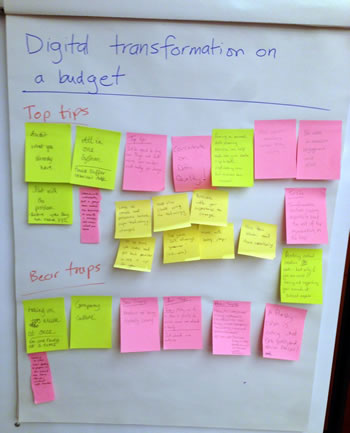
MemberWise Digital Excellence 2018: Digital Hacks
Digital Excellence is the digitally-focused membership conference from the MemberWise network.
This year I was co-chairing a series of eight ‘Digital Hack’ seminars with Dr Stuart Glen, Member Services Director at Institute of Chartered Foresters.
This article summarises the key points from each of our sessions.

What is a hack session?
Hack sessions are for sharing of ideas from each and every attendee. A mini round-table discussion, if you like. They are a far cry from the usual broadcast presentation.
Each session was 30 minutes. We structured the time as:
- Introduction and explanation of session by chair. (5 mins)
- Small group discussions, with around 5-7 people per group. Key points noted and placed on flipchart. (15 mins)
- Review and discussion of outputs as a group, led by the chair. (10 mins)
We followed the Chatham House Rule: attendees were free to report on and use the information shared but not identify the source, either implicitly or explicitly.
The aim was to create a safe space for everyone to engage in the conversation and leave with new ideas and insights.
Initial feedback received suggested this is exactly what happened. Here are the key points from the eight sessions.
1: Attracting millennials online & keeping them – top tips & bear traps
Top tips

- Promote membership as aspirational.
- Provide a clear incentive to join or register interest. Demonstrate the member value upfront.
- Review you member journeys. Ensure there are suitable pathways for younger members.
- Ensure the language used is relatable to your audience.
- Keep things quirky. Create authentic content that’s fun to share.
- Webinars can be a great way to introduce and promote membership benefits. Facebook Live provides additional audience exposure. One attendee shared how they broadcast a scheduled webinar on Facebook live and increased the audience from the 20 pre-booked people to over 200.
- Encourage and promote knowledge sharing by existing members. Make new members feel welcome.
- Consider mentoring new members by more established members.
Bear traps
- Don’t hide member benefits from non-members. Make your member value proposition obvious and working as an incentive to join.
- Choose your communications media carefully. Ensure you communicate in the way your audiences do and in places they frequent.
- Don’t assume recipients of your messaging have your level of understanding and knowledge of your organisation.
- Be wary of trying to do too much for millenials at the expense of your other audiences.
- Don’t make the jump from associate/student to professional member too complicated and/or expensive.
2: Digital transformation on a budget – where to focus in order to maximise value
Key points
- Review what you already have, and what is working well. The grass isn’t always greener on the other side.
- Company culture can stifle success. Work hard early on to get people on the same page. Form a group from around the business to feed into your strategy and validate key decisions. Have leaders hold regular sessions to keep the rest of the organisation in the loop.
- Determine how you’ll measure success, including member engagement and ROI.
- Ask your members what they want and what’s important for them.
- Start with the problem and desired outcomes, then find suppliers and technology to deliver these. Do not do it the other way around (tempting as it may be).
- Ask your suppliers/partners for their recommendations. Where can you derive greatest value? What can you do yourselves, and so make your budget work harder on the areas you can’t do?
- Don’t be afraid to try new things. Don’t assume your members aren’t ready for change.
- Focus on data quality. A flashy CRM is useless without high data quality and efficient processes.
- Don’t take on too much at once. Do one thing at a time. Stop starting and start finishing.
3: Leveling up – turning online engagement into participation and growth
Key points
- Determine which communication channels work best with your audiences and focus on these. It is absolutely fine to decide not to use social networks that aren’t a good fit.
- Video and visual content can be very effective. They don’t have to be slick and professionally produced. Low-fi explainer videos and webcasts work well. Perfect is the enemy of good.
- Make content shareable. If you have a lengthy report, tease our key stats or findings and make them inviting to share.
- Webinars are a great, low cost way to increase engagement and demonstrate value.
- Have a dedicated social media manager with responsibility for increasing engagement and participation. (This could be part of someone else’s role if you’re a small organisation).
4: The power of small data – simple data-driven actions that deliver big results
Key points
- Data quality is key. The effectiveness of any tactic is dramatically reduced if the input data quality is poor.
- Target communications as narrowly as possible, e.g. promoting specific benefits and updates based on member interest.
- Monitor engagement with different types of content. Do different segments of your membership respond better to certain formats?
- Relate everything to your member strategy – what are you trying to achieve as an organisation?
Examples I’ve worked on include event promotion based on member interest and booking status and automating upcoming renewal reminders.
5: Member metrics – effective measures and actions to develop online engagement
Effective metrics
- Number of members.
- Number of transactions (membership joining and renewals; event tickets; product purchases). Are any items frequently bought together, either in the same transaction or by the same people over time?
- First year membership renewal rate.
- Website logins.
- Event attendance.
- Payment method usage.
- Referrals from existing members.
- Member demographics and diversity monitoring.
- Reasons for attending events and leaving membership.
- Member benefit use, e.g. downloading material, use of helplines.
- Engagement scores, especially for premium members.
- Email open rates, clickthrough rates and best times for email engagement.
- Enquiry volumes, categories and conversion rates to new memberships.
Less effective metrics
- Number of website visits – which are hard to trust anyway.
- Time spent on page (website stats).
- Number of follower social media.
6: Digital transformation do’s and don’ts
Do
- Consult with and involve members.
- Prioritise the needs of your users (members) over those of the internal organisation.
- Focus on the problem and desired outcome, not the solution.
- Invest in solid project management skills.
- Assign named owners for specific issues and deliverables.
- Ensure the programme has senior ownership and appropriate governance.
- Understand digital transformation is a continuous journey, not a final destination.
Don’t
- Don’t underestimate the internal time and resource requirements. Ensure people have adequate capacity to do the work they need to do.
- Don’t think too big, or try and do too much at once.
- Don’t start with a fancy product with seductive marketing; focus on your requirements and then find the correct solutions.
- Don’t bespoke everything. Focus on playing to the strengths of your selected tools.
7: Future gazing – are new technologies (e.g. VR, AR, blockchain, chatbots) relevant for membership?

This was a fascinating session exploring new possibilities. Stuart kicked off by showing The Gruffalo Spotter, an augmented reality app developed by the Forestry Commission.
One delegate explained how they are using machine learning and AI to review and categorise academic publications. This has significantly reduced the time and costs associated with processing a large ongoing workload of new material. The outputs are also used to build a graph of research areas and key researchers. This graph is then interrogated to understand the hierarchy of influencers and identify gaps in current understanding that require additional research.
We discussed how chatbots could be relevant to assisting with membership enquiries, and blockchain could offer a means for professional bodies to validate people’s qualifications and career development.
But the broad conclusion was there is limited value of these new technologies in the membership sector at the moment. There are plenty of fancy solutions looking for problems – yet many membership organisations are still to truly implement more basic improvements.
8: Tools and techniques to maximise member retention
Key points
- Ask your lapsed members why they failed to renew. Identify patterns and implement strategies to address any ‘holes’ identified in your member journeys.
- Invest in engagement scoring and measurement to identify members at risk of churn. This can be (should be) very low-tech in the first instance while you experiment to understand how to score engagement for your membership.
- Engage new members early. Perceived value comes from first impressions. These early engagements have a far greater effect on retention rates than communications around the renewal date.
- Make it easy to renew. Use automated card billing and/or direct debits so no effort is required to renew.
- Avoid nasty surprises. Notify members in advance of their renewal being processed. This is a great opportunity to remind them of their benefits too.
Conclusion
I thoroughly enjoyed chairing this stream and being involved in the overall success of the conference. Thanks again to Stuart Glen, and Richard Gott and his team for making me so welcome (again).
The key takeaways were confirmations and validation of my existing beliefs:
- Digital success is a process of continuous, iterative experimentation and improvement. It’s a journey, not a destination.
- User (member) needs are what matters. Make life better for your members and the rest will follow.
- Focus on the outcomes first, and only then consider the technology. Use manual / low-fi approaches to determine the real process before looking into automation. Fake it till you make it.
Hacks are refreshing alternative to the usual platform presentations. They get the mind working and provide delegates with fresh networking opportunities. Could they be a useful format for your next event?
And speaking of next events, the MemberWise Membership Excellence conference is happening on 2 May 2019. Register your interest now.
Comments